 What you are wondering do Gallipoli and Troy have in common that they are in one post? Well the reason is one of geography, they are near each other and if you go to visit Gallipoli it is not far to stop and visit the remains of the ancient city of Troy.
What you are wondering do Gallipoli and Troy have in common that they are in one post? Well the reason is one of geography, they are near each other and if you go to visit Gallipoli it is not far to stop and visit the remains of the ancient city of Troy.
Gallipoli is the more recent and perhaps more moving of the two so let’s start there.
Ask any Australian or New Zealander what was the making of their country and you will get a one word answer. Either Gallipoli or ANZAC. They are synonymous with each other. As a young boy in the 1960’s I remember watching the ANZAC Day marches which were held in every town and suburb across Australia. I remember my uncles marching (they were World War 2 veterans).
So what is this fixation with Gallipoli and ANZAC?
The Australian Culture
Culture has always fascinated me. Australia started life as an English penal colony on the other side of the world in 1788. English sentences were harsh. Getting 7 years and being transported to Australia for stealing a loaf of bread to feed your family was not unheard of. Of course there was almost zero chance of being able to return to your family in England or Ireland after the sentence was completed. Needless to say there was a healthy disrespect towards all things English, which ingrained its way into the Australian psyche.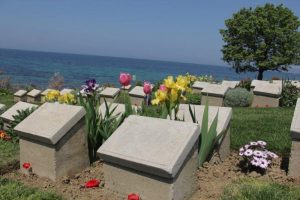
The archetypal British heroes are primarily females. Bodicea and Queen Victoria come to mind. And now maybe Queen Elizabeth who has been the queen for more than 60 years! Mother England is a common term.
The archetypal Australian heroes are male, bronzed, larrikins, not always on the right side of the law or taking their family responsibilities seriously. Ned Kelly and all the other bushrangers come to mind. It is indeed the exact opposite to the British archetype. I don’t believe that is an accident.
But when Britain called when WW1 started, Australia answered with gusto.
Short History leading to the Gallipoli Landing in 1915
Australia became independent from Britain in 1901. So at the grand age of 13 when World War 1 was declared, an incredibly high proportion of Australians volunteered to support the British Empire against the German Empire and later the Ottoman Empire, who sided with the Germans.
From a population of fewer than five million, 416,809 men enlisted. Think about that for a minute. That number represented 17% of the entire male population of Australia and maybe as high as 40% of available males of soldier age! And this wasn’t forced conscription, this was voluntary. It was all a bit of an adventure and Australians were excited to be involved.
But the war was a million miles away from Australia and New Zealand, even the troop ships took months to reach Cairo where they trained before the British decided where to deploy them.
Early in 1915, the war in the Western Front was going nowhere, so the British decided to attack German allies including Turkey. The daring aim of this action was to destroy Turkish forts on the Dardanelles Strait, thereby permitting access to Constantinople (Istanbul). Seeing British warships in Constantinople would crush the spirits of the Turks leading to a surrender and the opening up of sea lanes to Russia, an ally of Britain and France. However, following several abortive attempts to force the Dardanelles in February and March, the British Cabinet agreed that land forces could be used to storm the Gallipoli Peninsula to secure the Dardanelles Strait.
A Mediterranean Expeditionary Force (MEF) composed of British Empire (including Canadian and Indian) and French troops was hastily assembled in Egypt. Among the British Empire forces were the men of the AIF (Australian Imperial Force) and the NZEF (New Zealand Expeditionary Force) who had been training in Egypt when the decision to invade Turkey had been taken.
They were now combined into one army corps, known as the Australian and New Zealand Army Corps (ANZAC), and the men who fought in the corps became known as Anzacs.
The Gallipoli Campaign
At dawn on 25 April 1915, the ANZACs landed north of Gaba Tepe (the landing area later named Anzac Cove). This is a hilly area and the ANZAC’s had to dig in to escape the gunfire from the Turkish gunfire from the hilltops. This is how Australian troops attained their nick name of “diggers”.
The campaign was a disaster. The ANZAC’s made good territory on the first day but after that it developed into trench warfare, with neither side gaining an advantage. After 8 months and the war going nowhere, the British commanded the evacuation of the Gallipoli peninsula. This was the only successful part of the campaign with very few casualties sustained.
The allied casualties from this campaign were 141,000 of which 44,000 died. This included 8709 Australians and 2701 New Zealanders. The Turks suffered 251,000 casualties of which 86,000 died. A terrible toll.
While the campaign is considered a military failure, Gallipoli became a household name in Australia and with it the ANZAC tradition was created. Gallipoli became the common tie forged in adversity that bound the colonies and people of Australia into a nation.
Gallipoli Now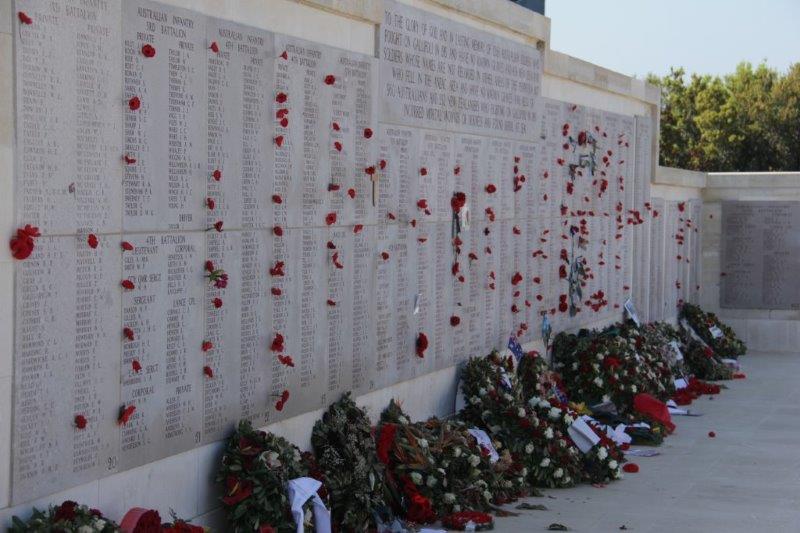
We visited Gallipoli on April 30, 2015, 5 days after the 100 year anniversary of the landing. It is a magnificent place to visit. The scenery is spectacular, the wild red poppies are in full bloom (it is only now that I understand the significance of the red poppy) as well as the tulips.
There are a series of cemeteries around ANZAC cove, maintained by the (British) Commonwealth War Graves Commission (CWGC). And they have done a magnificent job. The graves are beautifully maintained in a haunting, understated fashion. The gardens and lawns are spectacular. The CWGC have published some brochures that make it very easy to tour the cemeteries.
There were many people visiting the graveyards trying to make sense of it all or visiting a long lost relative or maybe just trying to work out what it means to be Australian. There were mementoes from home. Gumnuts, letters from relatives, flags. It was all very touching.
We visited many of the sites. Lone Pine, Johnston’s Jolly, Quinn’s Post, The Nek, Ari Burnu, Beach and Shrapnel Valley. They were all magnificent.
In some places the opposing trenches were less than 10 yards apart. For those interested there is a great film, Gallipoli, directed by Peter Weir and starring Mel Gibson. The finale of that film is frightening and when I saw it I thought it must have been exaggerated. But when you see the real battlefields it clearly wasn’t exaggerated; it’s what happened.
Australians and Turks
There are many myths around Gallipoli. There are stories of cricket matches being played and cigarettes being swapped between Turkish and Australian troops (after work). These may or may not be true. What is true was that there was a great respect between the 2 sides.
On more than 1 occasion, truces were declared so that both sides could clear their dead from the battlefield and bury them with some respect. There are stories of soldiers swapping cigarettes during the truces.
The Turks had no grudge against the ANZAC’s; it was the British they weren’t happy with. In a very touching memorial at Gallipoli are these words from 1934 from the great Turkish Prime Minister Ataturk (he was the military commander on the Turkish side in the Gallipoli campaign).
“Those heroes that shed their blood and lost their lives…
You are now lying in the soil of a friendly country. Therefore rest in peace. There is no difference between the Johnnies and the Mehmets to us where they lie side by side here in this country of ours…
You, the mothers, who sent their sons from faraway countries wipe away your tears; your sons are now lying in our bosom and are in peace, after having lost their lives on this land they have become our sons as well.”
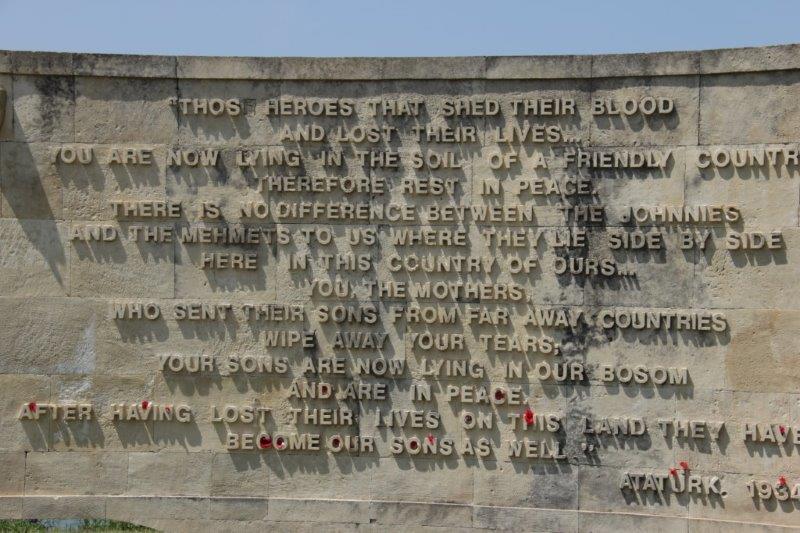
After having spent so much time in Turkey and having been to Gallipoli at the end of our time there, I have nothing but admiration for the Turks.
The Turkish people also have a national holiday, 18 March, which is the day the British and French fleet attacked the Turkish from the sea, the Turkish remembrances take place on this day in Canakkale.
Getting There and Where to Stay
Most people stay in Cannakale on the Asian side, as there is a bit more accommodation there. The problem with this is you have a ferry ride to negotiate before you can drive onto Gallipoli.
We hired our own car, driving up from Izmir. We stayed on the Gallipoli Peninsula only a 5 minute drive or so to ANZAC Cove, at The Gallipoli Houses. It can’t be too bad as Australian Prime Minister Julia Gillard stayed there!
The Gallipoli Houses
You cannot book into the Gallipoli Houses online. It is the old fashioned way, send an email, wait on a reply, and then confirm. However it was well worth it. I cannot recommend this place enough, it was excellent value, especially given the very limited accommodation options in the town. You will be:
- On the correct side and not have to deal with the ferry in the morning
- Very close to the actual site itself
- Join them for dinner, the food was excellent and great value to not have to go back into town
- It is peaceful and relaxing
- The host is fantastic. Erick is very knowledgeable and makes sure you are well prepared for your visit
- Guidebooks and maps are available
- He has a great wine selection as well and you can try some of the local vintages
- The rooms were comfortable and large
It’s just a really nice place to stay!
Onward to Troy!
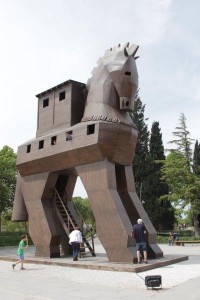
Troy is the ancient city in Homer’s The Illiad and, the site of the fabled Trojan Horse used during the Trojan War.
The town was long thought to be mythical and it lay in ruins for centuries until a German archaeologist decided to try and find it. There was a mound not far from the Straits of Dardanelles, known locally as Hisarlik, that held the remains of an ancient city known as Illium or Illion from Greek and Roman times. They decided to look here for the remains of Troy as it matched details from The Illiad. And he found Troy!
These are not well preserved ruins, and they have not undergone restoration or extensive excavations. Alone, I would not recommend a trip to visit the ruins of Troy. However, they are not far from Gallipoli, and are worthy of a stop since you are in the area.
The ruins are labelled Troy 1-Troy 9 and cover a number of settlements in the same area between 2500 BC and 500 AD when it was abandoned. It is somewhat interesting to see how they built on top of previous settlements, but there is not much remaining here.
For a view of what it might have been like to live in ancient Troy, the movie Troy (2004) based on Homer’s The Illiad is worth a watch.
This post also appeared as part of #Weekend Travel Inspiration 

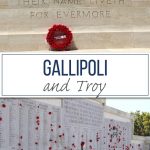
Voyager
The Trojan Horse has been a fascination from childhood for me, would love to visit these amazing places some day.
Editor
Yes it sounds like a fairy tale, but Troy actually exists. Troy and Gallipoli are beautiful part of Greece. Thanks for your comment.
Joe Ankenbauer
Some of my favorite periods of history were WWI and WWII. I’ve been meaning to come and check these places out, especially Troy. Thank you for the pleasant reminder!
Editor
Hi Joe. They are both very interesting places that’s for sure. Both of these places have been the subject of great films as well. Turkey is full of history. Thanks for your comment.
Lauren
Thanks for sharing this! I really have no knowledge of this aspect of our history, so it’s great to become enlightened about this! I love learning about history as I travel, too. Thanks for teaching me a few things 🙂
Editor
Hi Lauren. History is one of the more amazing aspects of a trip to Turkey. Modern and ancient. Some of the ruins there are remarkable. Thanks for your comment.
Mike
Super informative post, thanks so much for sharing. We spent some time in NZ and Australia during our trip, and we had heard of ANZAC, and even were there to see the poppys for sale and worn by everyone….but we didn’t learn near as much as i did from your blog.
Editor
Hi Mike. Anzac Day is revered in New Zealand and Australia. From an Australian perspective, I would say more important than Australia Day. Thanks for your kind comments.
Gemma
Very interesting. I knew that many British prisoners were sent to Oz but I wasn’t sure of the history behind it. I was even called a POM when I was in Australia. Naturally responded that I was Scottish but that’s a different story! Thank you for enlightening me.
Editor
Yes “pom” is a term of endearment for Australians that’s for sure. History is not a bad thing is it? Thanks for your comment Gemma.
Jessica
Very informative post. Learning History is indeed one of the best parts in traveling. Thank you for sharing this. 😉
Editor
Hi Jessica. Yes I think history is undervalued in the modern world. So much can be learned from what has occurred in the past. Thanks for your comment.
Jennifer McMillen
This would be certainly up my husband’s ally. He is a huge history buff. Thank you for the wonderful information. I hope to head down there eventually… in the near future.
Editor
An awesome place, Gallipoli. Very moving. Thanks for your comment.
Jennifer (Dr. J)
I’m fascinated by WWI and WWII history. We’ve visited Flanders Fields but haven’t been to Gallipoli yet. Thanks for sharing your experience there.
Editor
I know more about WWII than WWI. Through traveling I have to say I am learning more about history in general. including WWI. Maybe a better way to say it, is traveling is making history come alive for me. I can remember learning a lot of this stuff way back when in school, but seeing it in person is quite amazing.
Corinne
What a great article on Gallipoli and Anzac. As an American, I had no idea how important of a site it was until I visited a few years ago. Spending the day visiting the memorials and cemeteries that have such a gorgeous view of the Bosphorus Straits really has stuck with me.
Thanks for linking up with Weekend Travel Inspiration!
Editor
I have heard Gallipoli called Australia’s version of America’s Normandy. Probably not a bad description.
Michele {Malaysian Meanders}
War is such a terrible thing, isn’t it? I wonder how the families felt know that their boys were dead and buried so far from home. I’m glad that there’s a memorial for them and that their sacrifice won’t be forgotten. I’ve always wondered when the term ANZAC came into being, so thanks for clearing that up. Having read The Iliad for school, my teen has an interest in Troy. I’m glad to find out from you beforehand that it’s not worth a standalone visit but pairing it with Gallipoli seems like a great suggestion.
Editor
Hi Michelle. Thanks for your comments. It was indeed very sobering walking around Gallipoli. In terms of Troy, there are some other places worth seeing out of Ismir. It’s not too far from Troy. Here is a link to Ephemus, Pammukale and Bergama